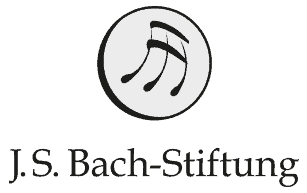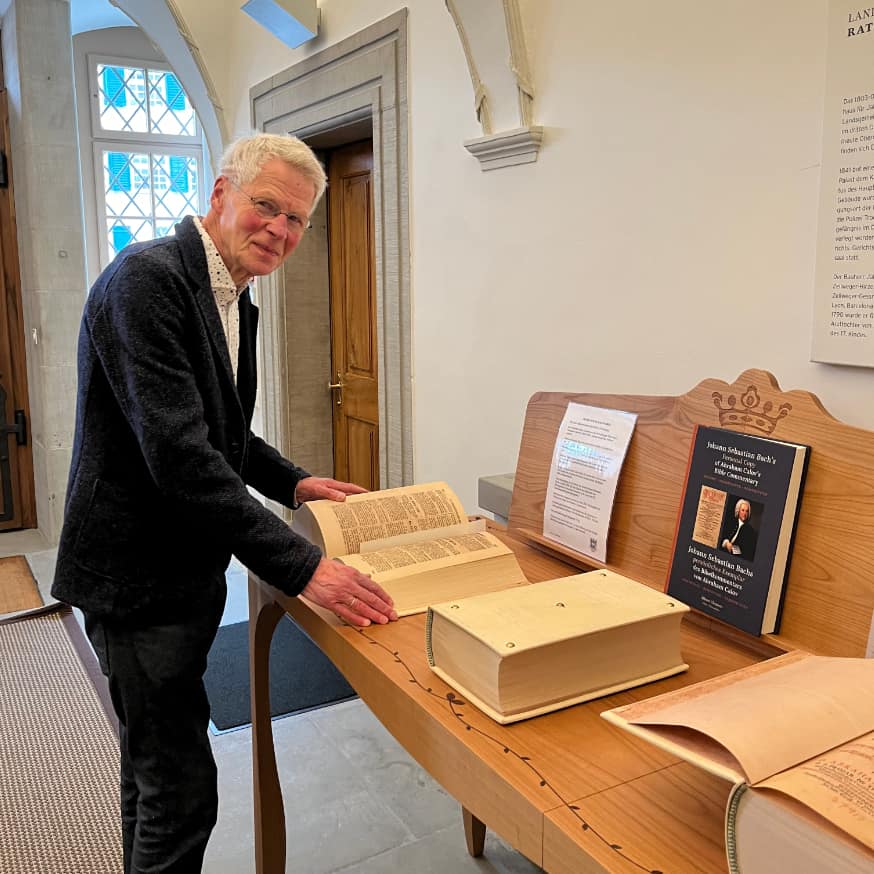J. S. Bach Foundation: How did you first discover the Bach Bible and what inspired you to print a facsimile edition?
Dingeman van Wijnen: In 1985 the American scholar Robin Leaver published a book about Bach’s Calov Bible, listing and illustrating the composer’s notes therein. Our publishing house has a tradition in producing and selling fine art facsimiles. Slowly the idea took hold that it would be wonderful to be able to study Bach’s own Bible and step into his spiritual world. I also felt the often-heard opinion that Bach’s relationship to the Bible was purely professional – that he was first and foremost a musician and not necessarily a believer – couldn’t stand up to scrutiny when Bach’s own Bible bears witness to a life lived closely to Luther’s theology.
The publication was a mammoth, 20-year undertaking. Could you walk us through the steps involved?
The very first step, in 1996, was presenting the idea to Concordia Seminary Library in St. Louis, where the Bach-Calov Bible resides. Librarian David Berger, though he could’ve voiced doubts about a small publisher in a far-off corner of a small European country embarking on such a venture, was enthusiastic and helpful right from the start. We initially tried to bring the project to Europe, negotiating with a printer from Graz to do the technical work. But ultimately St. Louis felt their responsibility for this unique treasure was too great to allow the volumes to travel and be handled outside the library. At a later stage, and with new digital developments, we succeeded in having the photography done in the library itself. We found a specialised printer in Poland and a wonderful book binder in the Netherlands. And there were around 80 buyers who ordered and paid for their copy in advance. That was very encouraging and helped finance the project.
What was the most unexpected discovery you made about the Bible on its road to publication?
The high number of markings and notes in Bach’s own hand and what they tell us about Bach’s life, interests and ideas. Unfortunately, only few of Bach’s personal documents survive; his Collected Letters would be a very slim volume indeed. His Calov Bible, however, offers us a glimpse into his heart. On a technical level, an unexpected discovery was the number of mistakes in the page numbering of the original volumes, which made it hard work to prevent a wrong ordering in the pages of the facsimile.
How have Bach enthusiasts and scholars responded to the facsimile edition?
At first, very often with surprise. When I visited St. Louis to discuss the project, on Sunday I visited the Lutheran church around the corner. No one knew that Bach’s Bible was right there in St. Louis! Not even the pastor or the organist. Bach scholars like Christoph Wolff, Peter Wollny and Bach interpreters like the late Nikolaus Harnoncourt, Ton Koopman, Masaaki Suzuki and many others, not least Rudolf Lutz, were thrilled by this opportunity to get closer to Bach in their scholarly and musical work. And, as said, quite a number of Bach lovers who could afford a copy ordered immediately, and we’ve heard back from many of them that they found it deeply touching to have this Bach treasure in their home.
What do you see as the role and value of facsimile editions in the digital age?
Facsimile editions and digital versions each have their own value. Bach Digital is a wonderful tool for studying Bach autographs, and, though I haven’t heard of any plans for this in St. Louis, Bach’s Calov Bible might well find a place there at a later stage. That said, nothing compares to examining a physical document in front of you. Professor Albert Clement, who edited the commentary volume to the facsimile edition and compiled a list of the almost 500 markings in Bach’s hand, could never have done the job without being able to quietly study the printed pages. Moreover, the touch and feel of the physical volumes provide an experience that a digital version can never match.
«THE TOUCH AND FEEL OF THE PHYSICAL VOLUMES PROVIDE AN EXPERIENCE THAT A DIGITAL VERSION CAN NEVER MATCH.»
What are your aspirations for the facsimile edition, and how would you like to see it disseminated and used?
We’ve now sold (and donated) around 160 copies. As a publisher, I hope we can sell another 840 copies worldwide in the coming years. Personally, I’ve found that the Calov Bible provides unique insight into Bach’s church music. Time and again when reading the commentaries to the Bible text – which Bach studied in close detail – the cantatas, motets and passions come alive in a wonderful way. I’m very grateful to see the facsimile being used by scholars for their research on Bach, by conductors and musicians to immerse themselves in Bach’s world, and by Bach enthusiasts to express their love of his music by giving this treasure a place in their home.
What has been the most surprising outcome of the publication?
What surprised me most was that so many Bach enthusiasts decided to pay thousands of euros in advance to a publisher they had never heard of, without seeing any samples, just because they felt the facsimile was an opportunity not to be missed. They were right, of course! I will always remember returning to the office after a holiday around 2014 to find a payment of 60,000 euros from our Japanese agent for advance orders in that country. As for the buyers of the facsimile, I had expected most would purchase a copy primarily to feel closer to Bach – more as a work of art than as volumes to read. Yet to my surprise, buyers, and not only the scholars among them, are studying the Bible for themselves. This reflects my own experience: exploring the Bible enhances one’s enjoyment of Bach’s music. Just recently I was asked to give an introduction to a performance of the motet ‘Jesu, meine Freude’ BWV 227. Reading the related commentary to Romans 8 in the facsimile helped me lead the audience through this wonderful work, and the text provided for several moving moments.
Knowing what you do now, would you attempt such a project again?
I must admit I’m glad I started the project while still in my forties. And there were moments when I doubted we would ever see the end result. But with people persuading me that if I didn’t persevere no one would ever attempt this again, and with so much help and encouragement, the project proved a great joy, and I would certainly do it again. I’m grateful to everyone who supported the project – and grateful to God that I’ve been allowed to see the publication being used and enjoyed by so many people.
«PEOPLE PERSUADED ME THAT IF I DIDN’T PERSEVERE, NO ONE WOULD EVER ATTEMPT THIS AGAIN.»
SPECIAL OFFER
Valid until end of June 2024
Van Wijnen Publishers is offering friends and patrons of the J. S. Bach Foundation the opportunity to purchase the fine art facsimile edition of the Bach-Calov Bible (three bible volumes + box + commentary volume) for a discounted price of only 5,000 euros (full price 5,500 euros).
In addition, for each copy sold, Van Wijnen Publishers will donate 500 euros to the Bach Foundation.
You can take advantage of the offer by contacting the J. S. Bach Foundation by email (vertrieb@bachstiftung.ch) or telephone (+41 (0)71 242 16 61). The foundation will pass your order on to the publisher, who will contact you to discuss your method of payment and delivery. Shipment to your place of residence is free of charge. The publisher’s donation of 500 euros is made directly to the J. S. Bach Foundation in St. Gallen.
FURTHER INFORMATION
A full account of the publishing project is given in the commentary to the facsimile edition entitled “Johann Sebastian Bach‘s Personal copy of Abraham Calov‘s Bible Commentary”. This duallanguage book in English and German is available for separate order at www.uitgeverijvanwijnen.nl.

